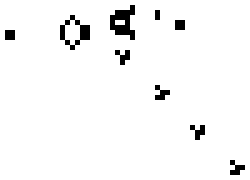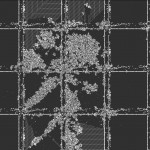Now go outside and look at the sky.
Life Revisited
Another post about my geeky childhood follows... :)
Maybe two years before I bought my first computer I read one of those "Science for 12-year olds" compilations with short illustrated essays about everything a boy in his early teens should be interested in - space rockets, lasers, radios, racing cars...
One of the articles in the book described a completely alien concept, a new kind of math: Cellular Automata. The focus of the essay was Conway's Game of Life, invented by John Conway, a mathematician with rather different ideas for the time. The essay had a photo of a dashing, young John Conway with a big smile on his face next to a huge computer terminal with a round screen - something that made sense when seen with a 70s design sensibility.
I must have read that article several times just to understand all the concepts that had been squished into it, remember, this was before I had ever touched a computer or heard of anybody who owned one. There were iterating cell structures, computer graphics, self-replicating cell formations...
And then there were examples of the simplest Life structures and illustrations on a grid of their first few generations. There were also instructions on how to try these structures at home on a chess board or on paper - which I of course immediately tried out. I was hooked, but processing Life manually was hard, hard work. So I went back to my Lego.
 Fast forward to 1982, and one of the first listings I typed into my shiny, new ZX81 was a 20x20 grid Game of Life simulation in Basic. The listing worked on the first try, which was spectacularily unusual, and it ran slooooow, which was as expected on the poor little ZX81. But it still beat manual processing by a factor of at least 1000, and gliders actually moved! So that's what Conway had been grinning about in that photo...
Fast forward to 1982, and one of the first listings I typed into my shiny, new ZX81 was a 20x20 grid Game of Life simulation in Basic. The listing worked on the first try, which was spectacularily unusual, and it ran slooooow, which was as expected on the poor little ZX81. But it still beat manual processing by a factor of at least 1000, and gliders actually moved! So that's what Conway had been grinning about in that photo...
Over the years I've installed - and occasionally programmed - versions of the Game of Life on every computer I owned. I usually didn't do any ambitious research with it, I just ran a bunch of glider cannons against each other and watched the carnage with much satisfaction. But still, I must have spent many hours of my life looking at the little cells doing their thing. The most frustrating aspect was that in 25 years we went only from 20x20 grids to 1280x1024...
For the last couple of years I hadn't been paying much attention to it, until a few nights ago when I stumbled over Golly. Somebody must have had a major revelation, and there is now something called the hashlife algorithm, that allows to run huge patterns in unlimited grids at very fast speeds! Once I had Golly installed on my Intel Duo Mac Mini, the speed with which this program runs million-bit grids is just amazing!
 I still don't have the inclination or energy to spend too much time researching the finer details of cellular automata, but some of the examples that come with Golly are mindboggling - several of the patterns start out with 6-10 million cells. See the picture to the right and compare with the animation above - a minor accident with a glider gun in a previously well-organized pattern of about 6 million cells, only about one million shown here. On my Mac Mini I'm getting about 6-10 generations per second at the time of the screenshot.
I still don't have the inclination or energy to spend too much time researching the finer details of cellular automata, but some of the examples that come with Golly are mindboggling - several of the patterns start out with 6-10 million cells. See the picture to the right and compare with the animation above - a minor accident with a glider gun in a previously well-organized pattern of about 6 million cells, only about one million shown here. On my Mac Mini I'm getting about 6-10 generations per second at the time of the screenshot.
Maybe I do have to spend some more time with the Game of Life...